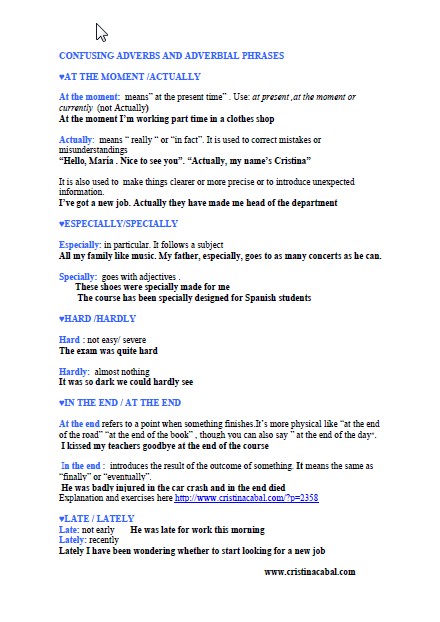Click the Play button to see the animated diagram.
Tag Archives: adverbs
A word on Grammar : Position of Adverbs in the Sentence and Confusing Adverbs and Adverbial Expressions
Exams are right around the corner and it is time to get down to some serious study and also time to pull your socks up. I don’t want any of you failing !
Learning the position of Adverbs in the sentence is one of the areas of grammar where the students’ instinct as to what sounds right or wrong will probably be more useful than studying the rules.
There are lots of adverbs that end in -ly; a useful tip would be to, when in doubt, put adverbs not ending in -ly ( even, just…etc) in mid -position that is, before the main verb.
Watch this presentation to help you remember the position of adverbs in the sentence but be ready to rely on your instinct whenever you are not sure.
and now that we are on the subject, let’s have a look at some confusing adverbs and adverbial expressions. There is a post published some time ago, dealing specifically with the confusing expressions at the end and in the end . Click here to read it and do some exercises!!
Now, click on the image to see the pdf below
Practise Adverbs of Manner and Intonation Having Fun
I don’t know about you, but most of my thinking time happens when I am driving all alone in my car. This is mainly because that must be about the only time in the day I am alone- Hey, I am not complaining here but it’s difficult to do any decent thinking we when you spend all your day surrounded by teenagers – my own and my students. So, here I was, in my car, driving to work and thinking about the best way to teach Adverbs of Manner to my students when I remembered an exercise I did while taking a course in IH London.

The idea is to combine Adverbs of Manner and Intonation in a very funny way, though to get to the funny part of the exercise there are, first of all, some steps to climb.
Step 1. This is the boring part. On the board, I write the adjectives I am going to use in Step 3 and ask students to form the adverbs of these adjectives(see worksheet ).
Step 2. Now it’s time to start working with intonation. I draw on the board a stave and demonstrate the power of intonation with the word Thank You! It might be necessary to repeat the expression a few times before students associate pitch with meaning
-low pitch= sarcastic, depressed, negative
-middle pitch= neutral
-high pitch = very positive
Students in pairs practise a few times.

Step 3. With the adverbs still on display on the blackboard I give each student a slip of paper with the adverbs of manner: furiously, quickly, cheerfully (Worksheet here). Students now stand up and in pairs tell each other the words I LOVE YOU using the correct pitch to convey the way they feel. The other student should be able to guess the adverb written on the card. Students move around the class talking to as many students as they can. Time limit: 5 minutes.
Step 4. Feedback: students, now, read their I LOVE YOUs aloud for everybody in the class to guess the adverb of manner.
Learn English and Have Fun!!
